2018 MITSUBISHI OUTLANDER III steering
[x] Cancel search: steeringPage 344 of 441
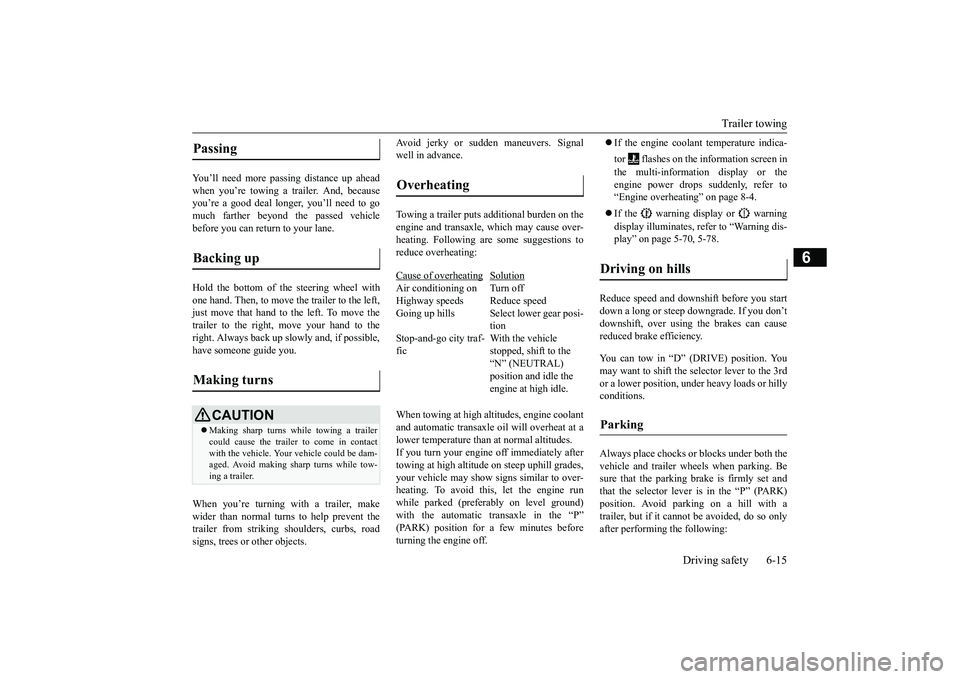
Trailer towing
Driving safety 6-15
6
You’ll need more passing distance up aheadwhen you’re towing a trailer. And, becauseyou’re a good deal longer, you’ll need to gomuch farther beyond the passed vehiclebefore you can return to your lane.Hold the bottom of the steering wheel withone hand. Then, to move the trailer to the left,just move that hand to the left. To move thetrailer to the right, move your hand to theright. Always back up sl
owly and, if possible,
have someone guide you.When you’re turning with a trailer, makewider than normal turns to help prevent thetrailer from striking shoulders, curbs, roadsigns, trees or other objects.
Avoid jerky or sudden maneuvers. Signalwell in advance.Towing a trailer puts additional burden on theengine and transaxle,
which may cause over-
heating. Following ar
e some suggestions to
reduce overheating:When towing at high al
titudes, engine coolant
and automatic transaxle oil will overheat at alower temperature than at normal altitudes.If you turn your engine off immediately aftertowing at high altitude
on steep uphill grades,
your vehicle may show
signs similar to over-
heating. To avoid this
, let the engine run
while parked (preferably on level ground)with the automatic transaxle in the “P”turning the engine off.
If the engine coolant temperature indica-tor flashes on the information screen inthe multi-information display or theengine power drops suddenly, refer to“Engine overheati
ng” on page 8-4.
If the warning display or warningdisplay illuminates, re
fer to “Warning dis-
play” on page 5-70, 5-78.
Reduce speed and downshift before you startdown a long or steep downgrade. If you don’tdownshift, over using the brakes can causereduced brake efficiency.You can tow in “D” (DRIVE) position. Youmay want to shift the selector lever to the 3rdor a lower position, under heavy loads or hillyconditions.Always place chocks or blocks under both thevehicle and trailer wheels when parking. Besure that the parking brake is firmly set andthat the selector lever is in the “P” (PARK)position. Avoid parki
ng on a hill with a
trailer, but if it cannot be avoided, do so onlyafter performing the following:
Passing Backing up Making turns
CAUTIONMaking sharp turns while towing a trailercould cause the
trailer to come in contact
with the vehicle. Your
vehicle could be dam-
aged. Avoid making sharp turns while tow-ing a trailer.
Overheating Cause of overheating
Solution
Air conditioning on Turn offHighway speeds Reduce speedGoing up hills Select lower gear posi-
tion
Stop-and-go city traf-fic
With the vehicle stopped, shift to the “N” (NEUTRAL) position and idle the engine at high idle.
Driving on hills Parking
BK0249100US.book 15 ページ 2017年5月10日 水曜日 午前8時49分
Page 363 of 441
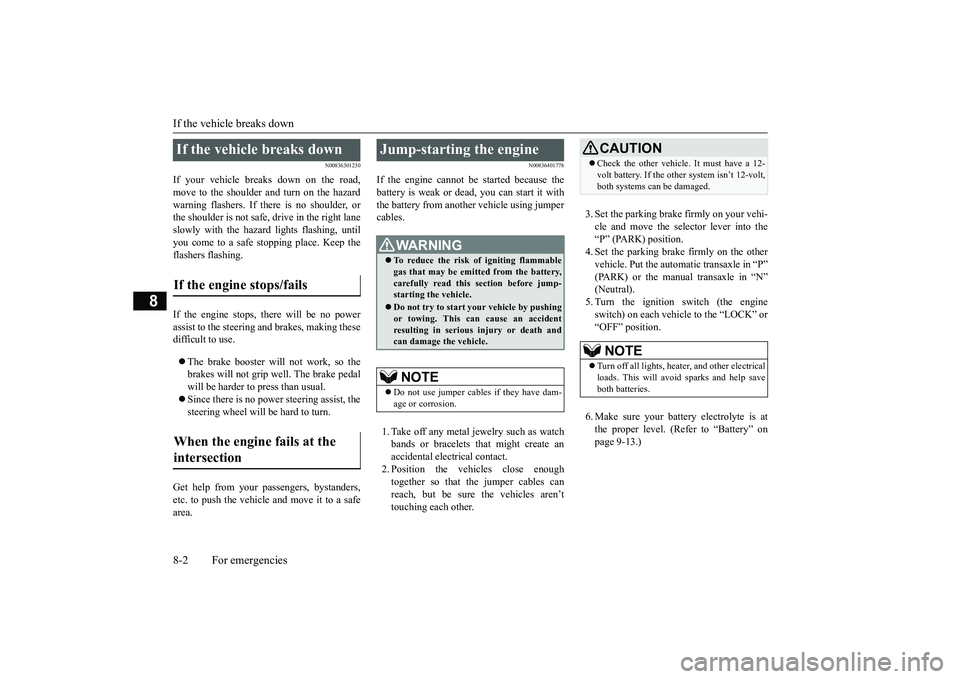
If the vehicle breaks down8-2 For emergencies
8
N00836301230
If your vehicle breaks down on the road,move to the shoulder and turn on the hazardwarning flashers. If there is no shoulder, orthe shoulder is not safe, drive in the right laneslowly with the hazard
lights flashing, until
you come to a safe stopping place. Keep theflashers flashing.If the engine stops, there will be no powerassist to the steering and brakes, making thesedifficult to use.The brake booster will not work, so thebrakes will not grip well. The brake pedalwill be harder to press than usual.Since there is no power steering assist, thesteering wheel will be hard to turn.
Get help from your passengers, bystanders,etc. to push the vehicle
and move it to a safe
area.
N00836401778
If the engine cannot be started because thebattery is weak or de
ad, you can start it with
the battery from anothe
r vehicle using jumper
cables.1. Take off any metal jewelry such as watchbands or bracelets th
at might create an
accidental electrical contact.2. Position the vehi
cles close enough
together so that the jumper cables canreach, but be sure the vehicles aren’ttouching each other.
3. Set the parking brake firmly on your vehi-cle and move the selector lever into the“P” (PARK) position.4. Set the parking brake firmly on the othervehicle. Put the automatic transaxle in “P”5. Turn the ignition switch (the engineswitch) on each vehicle to the “LOCK” or“OFF” position.6. Make sure your battery electrolyte is atthe proper level. (Refer to “Battery” onpage 9-13.)
If the vehicle breaks down If the engine stops/fails When the engine fails at the intersection
Jump-starting the engine
WA R N I N GTo reduce the risk of igniting flammablegas that may be emitted from the battery,carefully read this section before jump-starting the vehicle.Do not try to start you
r vehicle by pushing
or towing. This can cause an accidentresulting in serious
injury or death and
can damage the vehicle.NOTE
Do not use jumper cables if they have dam-age or corrosion.
CAUTIONCheck the other vehicle.
It must have a 12-
volt battery. If the other system isn’t 12-volt,both systems can be damaged.NOTE
Turn off all lights, heat
er, and othe
r electrical
loads. This will avoid sparks and help saveboth batteries.
BK0249100US.book 2 ページ 2017年5月10日 水曜日 午前8時49分
Page 368 of 441
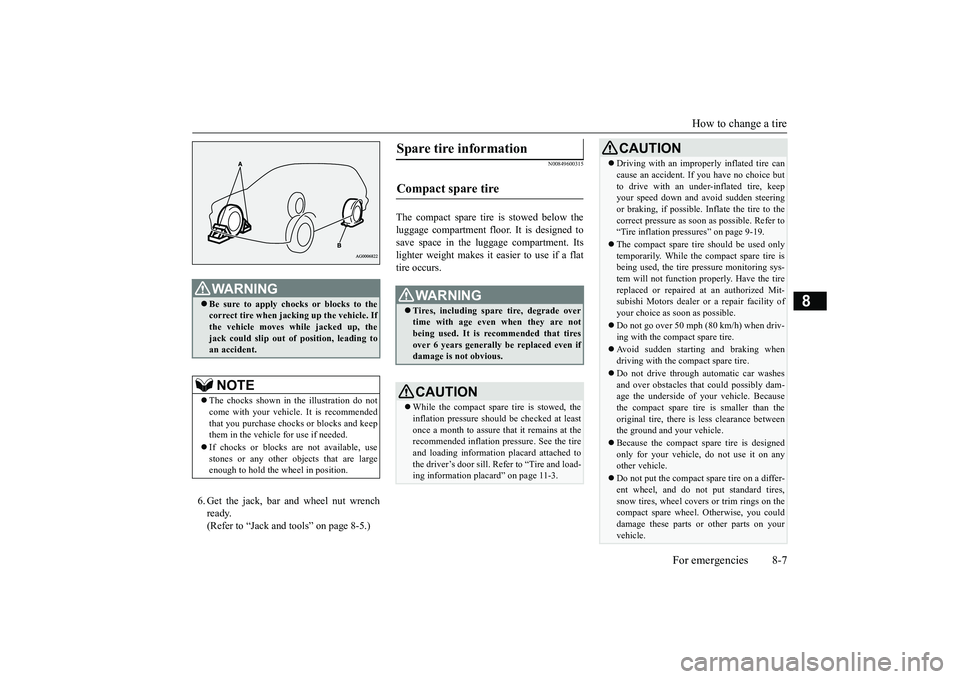
How to change a tire
For emergencies 8-7
8
6. Get the jack, bar and wheel nut wrenchready.(Refer to “Jack and t
ools” on page 8-5.)
N00849600315
The compact spare tire is stowed below theluggage compartment fl
oor. It is designed to
save space in the luggage compartment. Itslighter weight makes it easier to use if a flattire occurs.
WA R N I N GBe sure to apply choc
ks or blocks to the
correct tire when jacking up the vehicle. Ifthe vehicle moves while jacked up, thejack could slip out of
position, leading to
an accident.NOTE
The chocks shown in the illustration do notcome with your vehicl
e. It is recommended
that you purchase chocks or blocks and keepthem in the vehicle for use if needed.If chocks or blocks
are not available, use
stones or any other obj
ects that are large
enough to hold the wheel in position.
Spare tire information Compact spare tire
WA R N I N GTires, including spar
e tire, degrade over
time with age even when they are notbeing used. It is recommended that tiresover 6 years generally
be replaced even if
damage is not obvious.CAUTIONWhile the compact spare tire is stowed, theinflation pressure shoul
d be checked at least
once a month to assure that it remains at therecommended inflation pressure. See the tireand loading informati
on placard attached to
the driver’s door sill. Refer to “Tire and load-ing information placard” on page 11-3.
Driving with an imprope
rly inflated tire can
cause an accident. If
you have no choice but
to drive with an under-inflated tire, keepyour speed down and avoid sudden steeringor braking, if possible. Inflate the tire to thecorrect pressure as s
oon as possible. Refer to
“Tire inflation pressures” on page 9-19.The compact spare tire should be used onlytemporarily. While the compact spare tire isbeing used, the tire pr
essure monitoring sys-
tem will not function pr
operly. Have the tire
replaced or repaired at an authorized Mit-subishi Motors dealer or
a repair facility of
your choice as soon as possible.Do not go over 50 mph (80 km/h) when driv-ing with the compact spare tire.Avoid sudden starting and braking whendriving with the compact spare tire.Do not drive through automatic car washesand over obstacles that
could possibly dam-
age the underside of your vehicle. Becausethe compact spare tire is smaller than theoriginal tire, there is less clearance betweenthe ground and your vehicle.Because the compact spare tire is designedonly for your vehicle, do not use it on anyother vehicle.Do not put the compact spare tire on a differ-ent wheel, and do not put standard tires,snow tires, wheel covers
or trim rings on the
compact spare wheel. Otherwise, you coulddamage these parts or other parts on yourvehicle.CAUTION
BK0249100US.book 7 ページ 2017年5月10日 水曜日 午前8時49分
Page 372 of 441
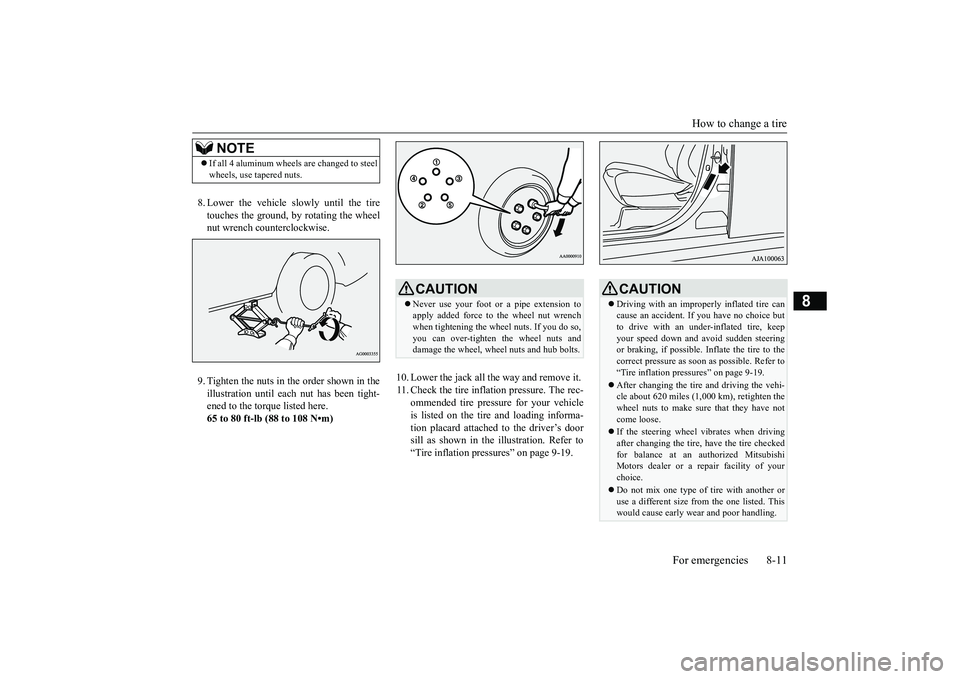
How to change a tire
For emergencies 8-11
8
8. Lower the vehicle slowly until the tiretouches the ground, by rotating the wheelnut wrench counterclockwise.9. Tighten the nuts in the order shown in theillustration until each
nut has been tight-
ened to the torque listed here.65 to 80 ft-lb (88 to 108 N•m)
10. Lower the jack all the way and remove it.11. Check the tire inflation pressure. The rec-
ommended tire pressure for your vehicleis listed on the tire
and loading informa-
tion placard attached to the driver’s doorsill as shown in the illustration. Refer to“Tire inflation pressures” on page 9-19.
NOTE
If all 4 aluminum wheels are changed to steelwheels, use tapered nuts.
CAUTIONNever use your foot or a pipe extension toapply added force to the wheel nut wrenchwhen tightening the wheel nuts. If you do so,you can over-tighten the wheel nuts anddamage the wheel, wheel nuts and hub bolts.
CAUTIONDriving with an imprope
rly inflated tire can
cause an accident. If
you have no choice but
to drive with an under-inflated tire, keepyour speed down and avoid sudden steeringor braking, if possible. Inflate the tire to thecorrect pressure as s
oon as possible. Refer to
“Tire inflation pressures” on page 9-19.After changing the tire
and driving the vehi-
cle about 620 miles (1,000 km), retighten thewheel nuts to make sure
that they have not
come loose.If the steering wheel vibrates when drivingafter changing the tire, have the tire checkedfor balance at an authorized MitsubishiMotors dealer or a repair facility of yourchoice.Do not mix one type of tire with another oruse a different size from the one listed. Thiswould cause ea
rly wear and poor handling.
BK0249100US.book 11 ページ 2017年5月10日 水曜日 午前8時49分
Page 396 of 441
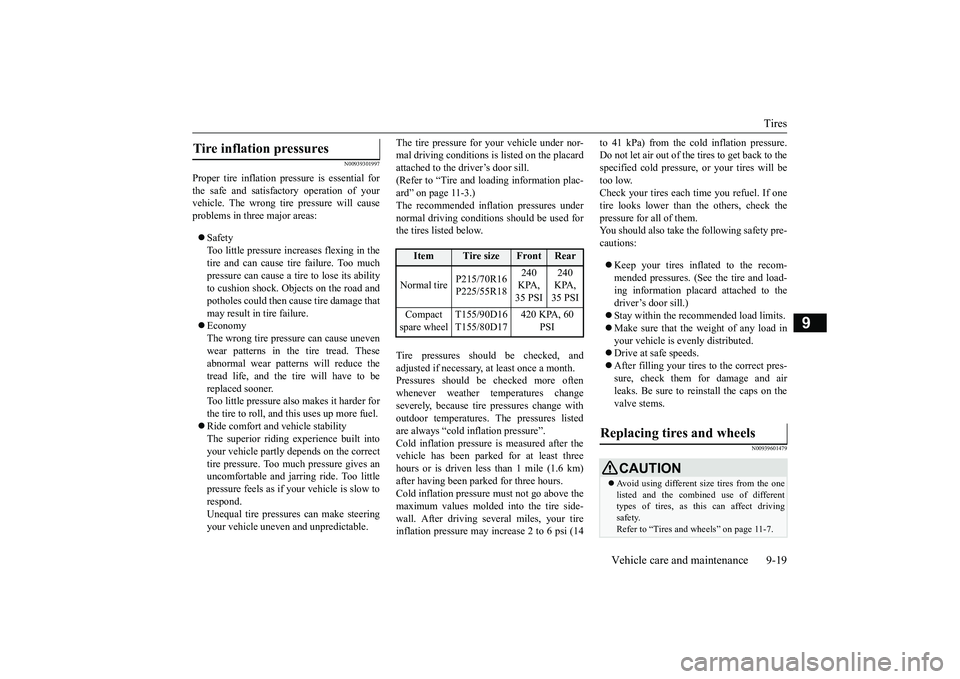
Tires
Vehicle care and maintenance 9-19
9
N00939301997
Proper tire inflation pre
ssure is essential for
the safe and satisfac
tory operation of your
vehicle. The wrong tire pressure will causeproblems in three major areas:SafetyToo little pressure increases flexing in thetire and can cause tire failure. Too muchpressure can cause a tire to lose its abilityto cushion shock. Objects on the road andpotholes could then ca
use tire damage that
may result in tire failure.EconomyThe wrong tire pressu
re can cause uneven
wear patterns in the tire tread. Theseabnormal wear patter
ns will reduce the
tread life, and the tire will have to bereplaced sooner.Too little pressure also makes it harder forthe tire to roll, and this uses up more fuel.Ride comfort and vehicle stabilityThe superior riding e
xperience built into
your vehicle partly de
pends on the correct
tire pressure. Too much pressure gives anuncomfortable and jarring ride. Too littlepressure feels as if
your vehicle is slow to
respond.Unequal tire pressure
s can make steering
your vehicle uneven
and unpredictable.
The tire pressure for your vehicle under nor-mal driving conditions is listed on the placardattached to the driver’s door sill.(Refer to “Tire and loading information plac-ard” on page 11-3.)The recommended inflation pressures undernormal driving conditions should be used forthe tires listed below.Tire pressures should be checked, andadjusted if necessary, at least once a month.Pressures should be checked more oftenwhenever weather temperatures changeseverely, becaus
e tire pressures change with
outdoor temperatures. The pressures listedare always “cold in
flation pressure”.
Cold inflation pressure is measured after thevehicle has been parked for at least threehours or is driven less than 1 mile (1.6 km)after having been parked for three hours.Cold inflation pressure must not go above themaximum values molded into the tire side-wall. After driving several miles, your tireinflation pressure may increase 2 to 6 psi (14
to 41 kPa) from the cold inflation pressure.Do not let air out of the tires to get back to thespecified cold pressure, or your tires will betoo low.Check your tires each t
ime you refuel. If one
tire looks lower than the others, check thepressure for all of them.You should also take the following safety pre-cautions:Keep your tires inflated to the recom-mended pressures. (See the tire and load-ing information placard attached to thedriver’s door sill.)Stay within the recommended load limits.Make sure that the weight of any load inyour vehicle is evenly distributed.Drive at safe speeds.After filling your tires to the correct pres-sure, check them for damage and airleaks. Be sure to reinstall the caps on thevalve stems.
N00939601479
Tire inflation pressures
Item
Tire size
Front
Rear
Normal tire
P215/70R16P225/55R18
240 KPA, 35 PSI
240 KPA, 35 PSI
Compact spare wheel
T155/90D16T155/80D17
420 KPA, 60
PSI
Replacing tires and wheels
CAUTIONAvoid using different size tires from the onelisted and the combined use of differenttypes of tires, as this can affect drivingsafety.Refer to “Tires and wheels” on page 11-7.
BK0249100US.book 19 ページ 2017年5月10日 水曜日 午前8時49分
Page 401 of 441

General maintenance9-24 Vehicle care and maintenance
9
high heat sources such
as the exhaust mani-
fold.
N00941400187
If the fuel-vapor vent line is clogged or dam-aged, the fuel-vapor mixture will escape, pol-luting the air.Have the system checked at an authorizedMitsubishi Motors dealer at the mileage spec-ified in the “WARRANTY AND MAINTE-NANCE MANUAL”.
N00941501299
The next pages list th
e maintenance service
recommended by Mitsubishi Motors Corpo-ration. In addition to the general maintenancethat needs to be performed at the times listed,
there are other parts which do not usuallyneed regular maintenance.But, if any of these parts stops working prop-erly, your vehicle performance could suffer.Have these items checked if you notice aproblem with them.If you have any questions, see your autho-rized Mitsubishi Motors
dealer for assistance.
N00941600059
Good brakes are essential for safe driving.Check the brake pads for wear. For goodbraking performance, replace the brake padswith the same type pa
ds as the originals.
N00941700076
Brake hoses and tubing should be checkedfor:Severe surface cracking, scuffing or wornspots. If the fabric casing of the hose isshowing through any cracks or worn spotsin the rubber hose cover, the hose shouldbe replaced. The brakes can fail if thehose wears through.Improper installati
on may cause twisting,
or wheel, tire or
chassis interference.
N00941800093
Check the following parts for damage andgrease leaks:Ball joint boots of the suspension andsteering linkageBellows on both ends of the drive shaft
N00942201118
The best way to keep carbon monoxide gasfrom entering inside your
vehicle is to have
the engine exhaust syst
em properly serviced.
Have a competent mechanic inspect the com-plete exhaust system
and nearby body areas
for broken, damaged, deteriorated, or mispo-sitioned parts if you no
tice any of the follow-
ing:A change in the sound of the exhaust sys-temThe smell of exhaust fumes inside thevehicle
WA R N I N GIf you see a fuel leak
or if you smell fuel,
do not run the engine. Any spark (includ-ing from the ignition
), flame or smoking
material could cause an explosion or fire.Call an authorized
Mitsubishi Motors
dealer or a repair fa
cility of your choice
for assistance.
Evaporative emission control system (except evaporative emission canister) General maintenance
Disc brake pads Brake hoses
Ball joint, steering linkage seals, drive shaft boots Exhaust system
WA R N I N GCarbon monoxide gas
from your vehicle’s
exhaust is poisonous. Breathing thesefumes can cause unconsciousness or death.
BK0249100US.book 24 ページ 2017年5月10日 水曜日 午前8時49分
Page 405 of 441

Fuses9-28 Vehicle care and maintenance
9
*: Fusible linkSome fuses may not be installed on yourvehicle, depending on
the vehicle model
or specifications.The table above show
s the main equip-
ment corresponding to each fuse.
7 12 V power outlet 15 A8 Rear window wiper 15 A9 Sunroof 20 A10 Ignition switch 10 A11 Option 10 A12
Hazard warning
flasher
15 A
13 4-wheel drive system 10 A14
Stop lights (Brake lights)
15 A
15 Gauges 10 A16 SRS airbag 7.5 A17 Radio 15 A18 Control unit relay 7.5 A19
Interior lights(Room lights)
15 A
20 Back-up lights 7.5 A21
Heated outside rearview mirrors
7.5 A
22
Outside rearview
mirrors
10 A
No.
Sym-bol
Electrical system
Capacity
23
Cigarette lighter/12 V power outlet
15 A
24
Charge 7.5 A
Heated steering
wheel
15 A
25
Power seat(Driver seat)
30 A*
26 Heated seats 30 A27
Power seat(Passenger seat)
No.
Sym-bol
Electrical system
Capacity
Engine compartment fuse location table No.
Sym-bol
Electrical sys-
tem
Capacity
SBF1
Air condition-ing condenser fan motor
30 A*
VLC 40 A*
Behind the fuse block coverMain fuse block
BK0249100US.book 28 ページ 2017年5月10日 水曜日 午前8時49分
Page 436 of 441

Alphabetical index
12-1
12
Numerics
12 V power outlets
............................
5-230
4-wheel drive operation
.......................
5-88
A
Accessory (installation)
.........................
3-6
Active stability control (ASC)
............
5-100
Adaptive Cruise C
ontrol System (ACC)
.......
5-107Air cleaner filter
...................................
9-9
Air conditioner
Dual-zone automatic climate control airconditioner
.....................................
7-5
Important air condi
tioning operating tips
..
7-13
Air purifier
.........................................
7-14
Airbag
...............................................
4-35
All-wheel drive operation
....................
5-88
Aluminum wheels
...............................
9-43
Anti-lock braking system
.....................
5-97
Arm rest
.............................................
4-10
Assist grip
........................................
5-246
Automatic high beam system
.............
5-211
Automatic transaxle
............................
5-68
Fluid
.....................................
9-11
, 11-7
Selector lever operation
...................
5-68
Selector lever positions
...................
5-71
Sports mode
...................................
5-72
B
Back-up light
Bulb capacity
.................................
9-32
Replacement
..................................
9-38
Ball joint, steering linka
ge seals, drive shaft
boots
...............................................
9-24
Battery
..............................................
9-13
Charging system warning light
.......
5-204
Checking battery
electrolyte level
....
9-13
Disconnection and connection
.........
9-14
During cold weather
.......................
9-14
Specification
..................................
11-6
Blind Spot Warning (BSW)
................
5-126
Bottle holders
....................................
5-243
Brake
Fluid
.....................................
9-13
, 11-7
Brake assist
........................................
5-96
Braking
Anti-lock braking system
................
5-97
Braking
...........................................
6-5
Hose
.............................................
9-24
Pad wear alarm
..............................
5-93
Parking brake
.................................
5-53
Pedal
.............................................
5-92
Pedal free play
...............................
9-22
Power brakes
.................................
5-92
Service brake
.................................
5-92
Warning lights and buzzer
.............
5-203
Break-in recommendations
....................
5-3
Bulb capacity
......................................
9-32
C
California Perchl
orate Materials
Requirements
.....................................
3-7
Capacities
..........................................
11-7
Card holder
............................
5-229
, 5-240
Cargo area cover
...............................
5-244
Cargo loads
........................................
6-10
Cargo room light
...............................
5-238
Bulb capacity
.................................
9-33
Catalytic converter
................................
9-2
Cautions on the handling of all-wheel drive vehicles
............................................
5-91
Certification label
...............................
11-3
Charging system warning light
...........
5-204
Child restraint systems
........................
4-27
Child safety locks for rear door
............
5-37
Cleaning
Inside of your vehicle
......................
9-40
Outside of your vehicle
...................
9-41
Coat hook
.........................................
5-246
Consumer information
.........................
10-2
Continuously variable transmission (CVT)
...
5-75
BK0249100US.book 1 ページ 2017年5月10日 水曜日 午前8時49分